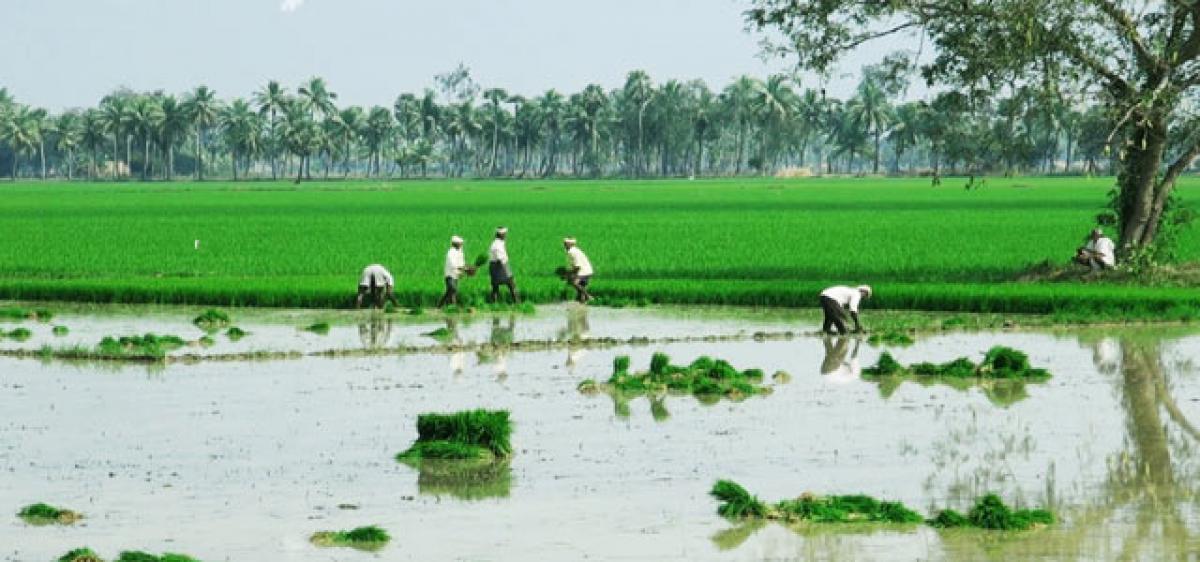Live
- Govt plans to establish offshore Johns Hopkins University Campus in India
- Goa Aces clinch Indian Racing League title
- Study finds how hormone therapy can reshape the skeleton
- High-street fashion players looking at India for manufacturing: Report
- Shreyas Iyer to lead Mumbai as Prithvi Shaw returns for Syed Mushtaq Ali Trophy
- 'Failed to resolve crisis': NPP withdraws support from BJP govt in Manipur
- Chennai: Actress Kasturi Remanded in Custody Until 29th of This Month
- Aaqib Javed likely to become Pakistan's new white-ball head coach
- BJP panel to draft poll charge sheet against AAP govt in Delhi
- Allu Arjun Thanks Fans in Patna, Teases 'Pushpa 2' Release
Just In
Sluggish growth nails Government rosy picture on agriculture progress


The disturbing growth trends in agriculture raising serious concerns over food security. In the first half year in 2015-16, the particular sector showed negative growth with -6.99 per cent even as the overall growth in Agriculture and allied sector remained at 25.4 per cent.The forecasts relating to agriculture in the next half year of the fiscal also may not present a rosy picture, thanks demonon
Vijayawada: The drop in growth in agriculture in the State in the first half year of the current fiscal seemingly queer’s the Chief Minister N. Chandrababu Naidu’s pitch for double growth. As per the growth trends which were officially made available during the two-day Collector’s conference a few days ago, agriculture clocked only 3.79 per cent over the targeted 21.45 per cent during the period. The performance of Agriculture and allied sector as a whole presented a different picture with 30.09 per cent as against the target of 25.6 per cent. The other allied sectors such as livestock, horticulture, fishing, forestry and logging performed well, even as some of them like fishing surpassed the expectations. It is mainly because of aquaculture, the trends in agriculture and allied sectors over-all looked bright and promising. The particular sector alone helped the State register a gross value audit (GVA) of 8459cr with 52.94 per cent during the first half year because of this reason, thanks to its huge export potential.
The disturbing growth trends in agriculture raising serious concerns over food security. In the first half year in 2015-16, the particular sector showed negative growth with -6.99 per cent even as the overall growth in Agriculture and allied sector remained at 25.4 per cent.The forecasts relating to agriculture in the next half year of the fiscal also may not present a rosy picture, thanks demononitisation of high-value currency notes which impacted khariff marketing prospects. The state witnessed complaints galore that about there being no takers for agriculture produce during the season due to cash crisis. This demonitisation effect may continue to persist in rabi also. It became a daunting task for mobilizing investments in the form of hard cash for farmers to purchase inputs and pay wages during the rabi operations.
According to Akkineni Bhavani Prasad, a peasant leader from the Krishna delta, the government’s drive for rapid industrialization as part of the ambitious plan to groom the successor state as “sunrise AP” and urbanization are the main causes for agriculture registering sluggish growth. The government has planned to create a land bank with 13 lakh acres enabling to trigger the process for industrialization in the state. A vast extent of lands is giving way to urbanization and infra projects like highway expansion, ports and airports. Strikingly, more than 30,000 acres of fertile lands made way for capital building in Amaravati region itself. Bhavani Prasad estimated that around 20 lakh out of 60 lakh acres of cultivable lands disappeared into townships, special economic zones and the other projects in the last few years.
Paddy is grown in 40 lakh acres in Penna-Tunga Bhadra, Krishna and Godavari delta systems with an annual production of 1.2cr tons per year. Agriculture scientists express concern over the productivity either remaining constant or taking a nosedive due to soil fatigue caused by excessive use of fertilizers and pesticides. The peasant leaders pointed out that the government is doing nothing to improve soil health to boost agricultural production. Peddireddy Chengal Reddy, another peasant leader said agriculture has been a witness to the phenomenon of absentee landlordism with more than 80 per cent of land in the delta regions slipping into the hands of tenant farmers since agriculture proved to be economically not viable.
Erratic behavior of monsoons in the form of floods in the delta regions and recurring droughts in Rayalaseema and north coastal regions also contributes to poor growth in agriculture. More than 50 per cent of groundnut crop in Rayalseema region failed in the current season for want of rains.
-BY G Nagaraja

© 2024 Hyderabad Media House Limited/The Hans India. All rights reserved. Powered by hocalwire.com






